The blue lingcod (Ophiodon elongatus) is a rare type of aquatic species. Many of the Alaskan fishermen used to catch these bluefish while fishing in the Pacific Ocean.
Lingcod is a west coast bottom-dwelling fish, wherein in some instances you will see an alien-like blue color skin. This blue lingcod typically has a white-hued like a halibut.
Lingcod lurk among rocky reefs, which are in Baja California, to the Gulf of Alaska.
These fish are; one of the coast’s most fearsome predators and patient, indiscriminate ambush hunters that explode from their cover to catch any helpless prey that would swim past them.
This fish is neither true ling nor true cod. But, lingcod belongs to a family called the greenlings ( Hexagrammidae).
In fact, Ophiodon elongatus is an evolutionary oddball and the only genus member serving the genus Ophiodon. These species have long—eely bodies.
Lingcod have an extensive mouth which makes them so fearsome.
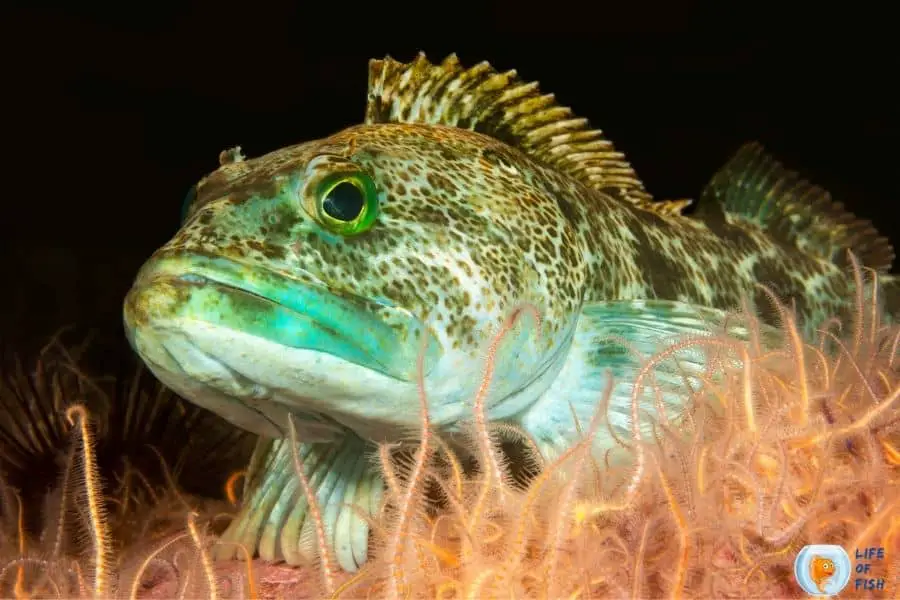
What Does blue lingcod look like?
Jump To
Male and female lingcod mature at age three to five years (61–75 cm [24–30 in]) and two years of age (45 cm[18 inches]), respectively.
A fully grown male can be distinguished externally from a female by a minor, conical papilla below its anal vent.
Up to age two, males lingcod and females species can grow at the same size, where both males and females could reach an average length of 45 cm (18 in).
After age two, females lingcod will overgrow than males, with male lingcod fish tapering off at about age 8, and the female will continue to grow until the age 12 – 14.
These species are known to live a maximum of about 36 years. Blue lingcod has blue-colored skin. This blue tint typically has a white-hued like a halibut.
Where do blue lingcods live?
Lingcod is native to the North American West Coast from Shumagin Island in Alaska to Baja California, Mexico.
You can often find these species on the bottom of rocky areas at depths of 32 to 328 feet (10-100m), although some blue lingcod even live at depths up to 420m.
They often stay as individuals and are nonmigratory species that remain in the same colonized areas.
Even the juveniles eventually settle in similar relief and substrate habitats as older lingcod but stay at shallower depths for several years.
Blue lingcod’s can tolerate a broad range of water temperatures. The pH level of seawater is 8.0-8.4.
Why blue lingcod meat is blue
This fish has blue or rare turquoise color because of bile pigment called biliverdin, which is the leading cause of these species turning blue.
This condition makes the blood serum change to an odd color.
However, how this pigment will get into the tissues and flesh of the fish, or why just some lingcod flip this hanging shade, nonetheless leaves biologists puzzled.
Biliverdin can also be the pigment that is liable for that greenish color typically seen in bruises.
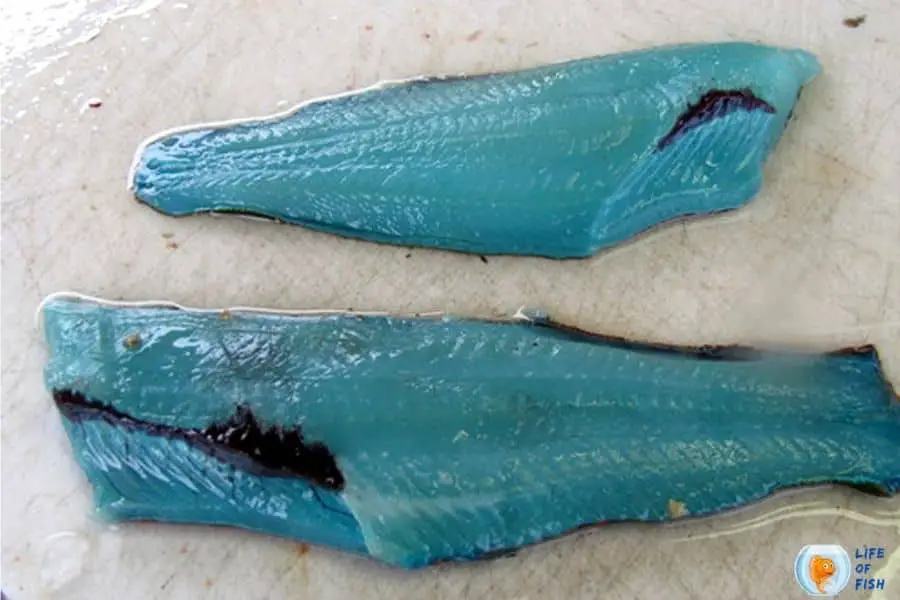
Blue lingcod behavior
Lingcod are solitary species and like to spend their time resting inside holes or crevices alongside the rocks.
These species camouflage their body into its rocky surroundings, where it lies in and waits to ambush any prey that swims by.
Sometimes you might see these species moving around in the shallow waters at night to feed.
What they eat
These lingcod are very prodigious predators and eat anything that these fishes could fit into their mouths, such as invertebrates and many other fish species.
Some examples are herring (Clupea pallasii), salmon, and Pacific hake (Merluccius products). Lingcod exhibits cannibalism.
These species prefer to eat smaller octopuses, and sometimes these fish might even hunt down large rockfish.
Main Diet
Carnivore – Eats eggs, eats non-insect arthropods, vermivore, molluscvore, and planktivore
Animal Foods;
fish, eggs, mollusks, aquatic or marine worms, pelagic crustaceans, other marine invertebrates zooplankton.
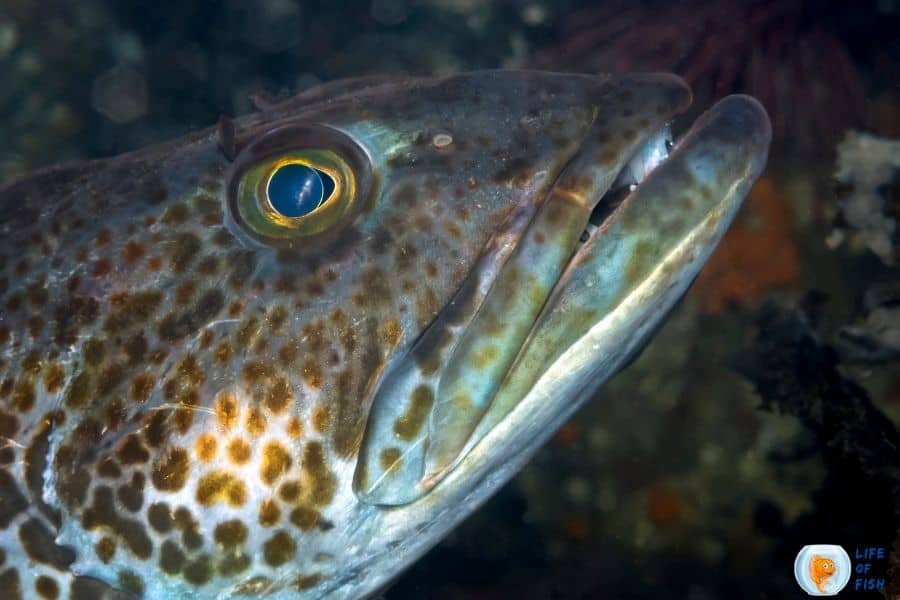
Blue Lingcod Breeding
Adult lingcod reproduce sexually utilizing external fertilization and exhibit both nesting and nest-tending activities.
The male will attract the females to their nesting site, where the female fish lay their eggs within the reef cracks and cavities.
A female lingcod will deposit around 40,000 to 50,000 eggs at a time.
Spawning Behaviour
Female lingcod often lay their eggs in layers, with each layer being fertilized before the next layer spreads.
Single lingcod males can fertilize the egg masses of multiple females.
The female will remain monogamous within the breeding season and spawn with only one male once per breeding season.
The male lingcod will return to their nesting site every year. On the other hand, the female exhibits no site fidelity and will even mate with a different male in another nesting site.
Spawning Season
The adult lingcod spawn seasonally, starting in the late winter. Spawning occurs between December and April in shallow waters 3 to 10 meters in depth near rocky reefs with strong tidal currents.
A male lingcod will be fully sexually mature by two years of age, and the female becomes sexually mature within 3 and 5 years of age.
The male fish starts to move towards the shore, spawning grounds to establish territorial boundaries and nest sites.
Typically, a male lingcod will have more than one nest site. And by chance, if a male finds a suitable nesting site, the male fish might return to that exact place every year until the male is no longer capable of spawning.
After seeing the perfect nesting site, a male lingcod does so to chase away the other males around the sites and start only to attract females to his territory.
Prenatal Care
The Female lingcod abruptly leaves the nesting site after laying the eggs.
The male has to defend the eggs against all intruders aggressively.
There are some instances where the male lingcod has tried attacking humans during the mating seasons.
The male will stay in the nesting site for 8 to 10 weeks until the eggs develop and fan with their pectoral tail fins to keep them oxygenated and clean.
Sometimes, you will see small males protect the nesting site. The small males are also capable of guarding the loose egg masses while the matured males are not present that have been removed from the reef and settled on the ocean floor.
Like many eggs of many aquatic species, lingcod eggs are highly vulnerable to numerous benthic predators.
Hence the male guarding the breading site is a significant part of the survival of the younger lingcod.
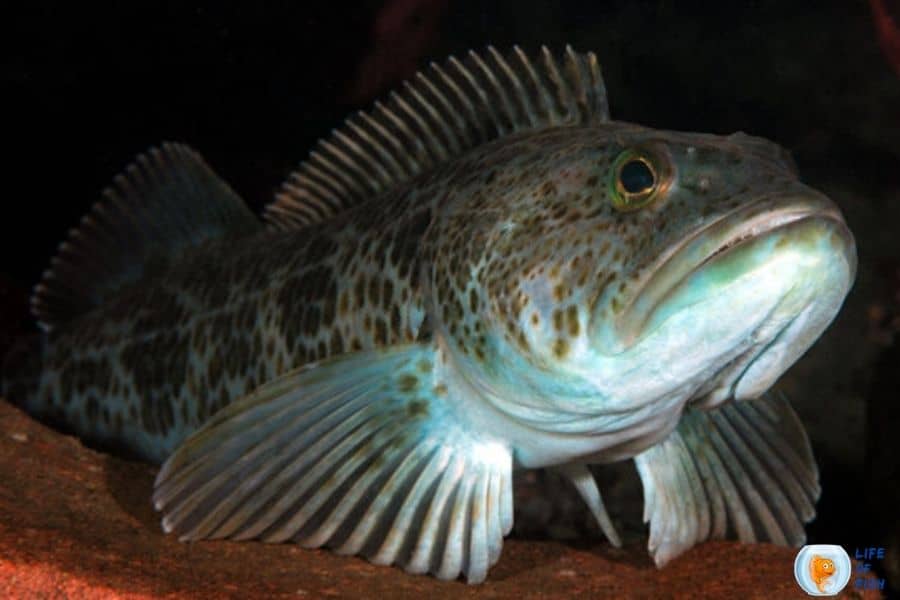
Importance of blue lingcod
Ecosystem Roles
Lingcod are essentially secondary and tertiary consumers within the benthic community.
These are ambush predators and prey upon squid, octopuses, crabs, fish, and more undersized lingcod.
They are also an important prey species for numerous species of marine mammals. The majority of the lingcod eggs are hunted and eaten by gastropod mollusks, crabs, echinoderms, kelp greenling, and cabezon.
The larvae and younger lingcod species may be eaten by anything more significant than themselves.
Sportfishing
Blue lingcod is popular as game fish among anglers because of its aggressive behavior.
The Lingcod fish has the heart of a warrior and bursts from the depths with anger that pins anglers to the rail.
Lingcod are challenging, elusive, and schooling fishes, where it may take a considerable amount of effort to catch them.
Anglers fishing the Southern California fishing grounds prize the Lingcod and favor the challenge of catching what is sometimes called the deep dragon.
The west coast, from Alaska to Baja, is the only place we can find these species.
As a Food
Blue lingcod is considered a delicacy among consumers because of its delightful taste and its flesh color.
Although it is an ugly fish, people love to eat it as it has a mild flavor profile similar to halibut or cod.
Food Habits
Lingcod fishes will mainly ambush their prey and eat anything that fits their mouths, especially large invertebrates and fish.
These species show cannibalism and prey on various species of salmon and rockfish as well as Pacific herring and octopus.
Economic Importance for Humans
From 1943 to 1950, the commercial landing of lingcod ranged from 326,000 to 950,000kg per year, mainly due to strong markets for fish liver oil.
From 1972 – 1982, landings significantly increased to 1,360,00kg per year due to the fast-growing expansion of trawl fishing along the Pacific west coast. In the 1980s, lingcod landings have steadily decreed in total weight and number of caught fish.
In 1999, the commercial harvest peaked at 142,000kg and had been valuing at $283,000. By 2009, the commercial landings have declined to around 57,000kg, valued at $184,000. And in 1980, the recreational catch totaled 626,945 fish, compared to 30,477 fish landed in 2008,
The decrease in numbers reflected the catch limits imposed by management plans that the California Department of Fish and Game implemented to conserve rockfish populations along the pacific coast of the UUS.
Predation
These species are cryptically colored and spend most of their time hiding in the bottom overhangs, amongst rocks, and inside holes.
A fully grown adult lingcod has very sharp long teeth to deter potential predators, where humans are the most significant lingcod predators, considered overfished in the late ’90s.
Ever since that, many regulations have been placing to reduce the annual harvest rates of lingcod. Other predators of lingcod are Harbor Seals, Sea Lions, Stellar sea lions, and sharks.
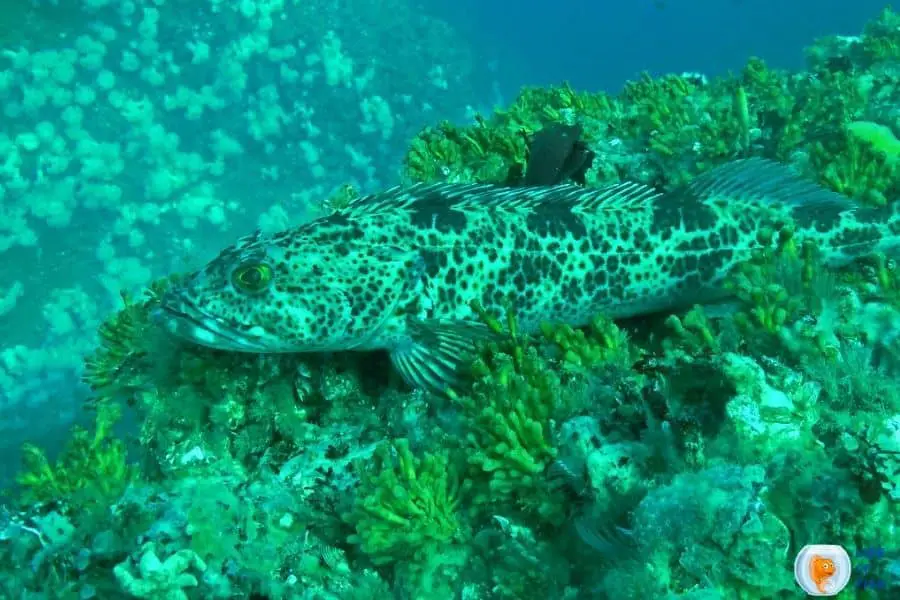
Related question
What kind of fish is a blue lingcod?
The lingcod or lingcod (Ophiodon elongatus), also known as the buffalo cod or cultus cod, comes from the family of Greenling Hexagrammidae. Blue lingcod is the only extant member of the genus Ophiodon.
Are blue lingcods rare?
Yes, Blue lingcod fish are pretty much the rarest type to find in the ocean. The main factor for this fish that makes them rare is the blue or green color variation that you can see in only 20% of the population.
Are blue lingcods poisonous?
No, Lingcod is not poisonous.
Can you eat blue lingcod?
Yes, A lot of people prefer lingcod over other fish. Lingcod is an ugly fish, but the taste is delightful. It flakes nice, and some cooks like to call it lobster-like. If it is prepared right, it can have that intense feeling.
What does lingcod taste like?
Although Lingcod is an ugly fish, the taste is delightful. It is a lean, white fish with a mild flavor profile similar to halibut or cod.
Its flesh holds a medium-firm texture with large flakes. The raw meat can, on occasion, have a blue-green shimmer, but it will disappear when cooked.
Health Benefits of Blue Lingcod
Lingcod is an excellent source of omega-three fatty acids. These are typically known to be helpful to promote heart health and lower cholesterol.
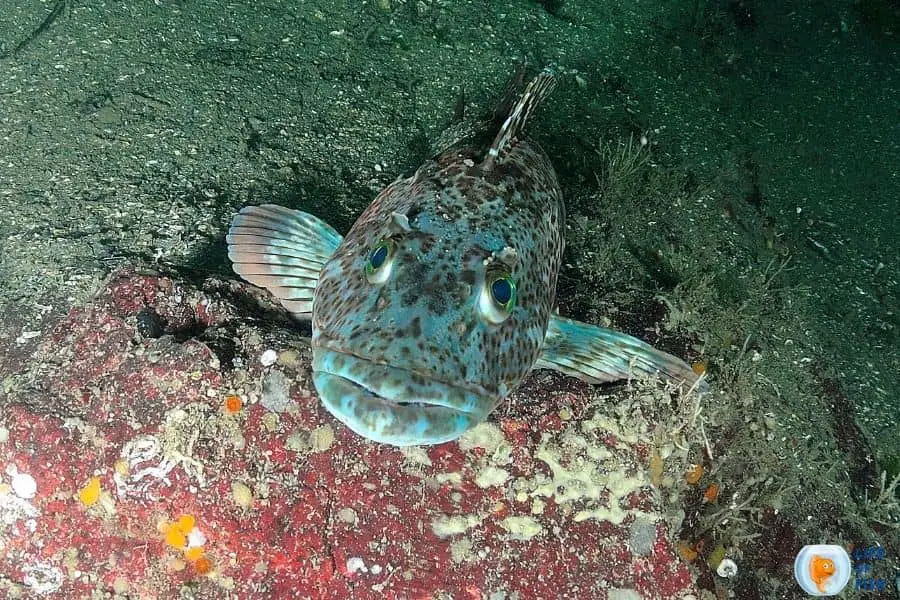
Conclusion
Lingcod fishes are one of the rarest types of fish that you would see in the Pacific Ocean. These species have a blue tint to their meat. any people like to consume lingcod. They are primarily known as a delicacy in many parts of the world.
Reference
- Silberberg, K.R., Laidig, T.E., Adams, P.B. and Albin, D.O.U.G.L.A.S., 2001. Analysis of maturity in lingcod, Ophiodon elongatus. California Fish and Game, 87(4), pp.139-152.
- DeMott, G.E., 1982. Movement of tagged lingcod and rockfishes off Depoe Bay, Oregon.
Read More: Albino Cory Catfish | 11 Highly Informative Facts About The Fish
